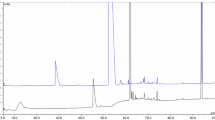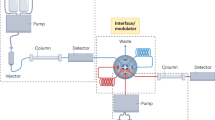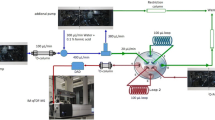Abstract
In this paper, we describe the findings of a study aimed at assessing the detection sensitivity of comprehensive two-dimensional high-performance liquid chromatography (LCxLC) separation of a degraded active pharmaceutical ingredient (API) with UV absorption as the detection technique. Specifically, we have examined the impact of the volume and solvent composition (referred to as “interface conditions”) of fractions of first-dimension column effluent transferred to the second dimension for further separation on the ability to resolve and detect low-abundance compounds. Historically, LCxLC has been perceived as being inferior to 1D-LC from the point of view of detection sensitivity. In this work, we demonstrate that LCxLC is sufficiently sensitive to be useful in the pharmaceutical context where in general impurities present at 0.05 % (relative to the API concentration) should be quantified. Moreover, we find that this level of sensitivity is only attained under certain conditions: dilution of the first column effluent with weak solvent (water in this case) prior to injection into the second-dimension column is very beneficial because it promotes focusing of the analyte band in the second column, thereby improving the detection sensitivity of the LCxLC system; and, quantitation limits are also a strong function of peak location in the second-dimension separation window, where baseline disturbances near the dead time of the second column can limit reliable detection of low-abundance compounds.










Similar content being viewed by others
References
Potts LW, Carr PW (2013) Analysis of the temporal performance of one versus on-line comprehensive two-dimensional liquid chromatography. J Chromatogr A 1310:37–44. doi:10.1016/j.chroma.2013.07.102
Guiochon G, Marchetti N, Mriziq K, Shalliker R (2008) Implementations of two-dimensional liquid chromatography. J Chromatogr A 1189:109–168. doi:10.1016/j.chroma.2008.01.086
Vivó-Truyols G, van der Wal S, Schoenmakers PJ (2010) Comprehensive study on the optimization of online two-dimensional liquid chromatographic systems considering losses in theoretical peak capacity in first and second-dimensions: a Pareto-optimality approach. Anal Chem 82:8525–8536. doi:10.1021/ac101420f
Davis JM, Stoll DR, Carr PW (2008) Effect of first-dimension under sampling on effective peak capacity in comprehensive two-dimensional separations. Anal Chem 80:461–473. doi:10.1021/ac071504j
Horie K, Kimura H, Ikegami T, Iwatsuka A, Saad N, Fiehn O, Tanaka N (2007) Calculating optimal modulation periods to maximize the peak capacity in two-dimensional HPLC. Anal Chem 79:3764–3770. doi:10.1021/ac062002t
Potts LW, Stoll DR, Li X, Carr PW (2010) The impact of sampling time on peak capacity and analysis speed in on-line comprehensive two-dimensional liquid chromatography. J Chromatogr A 1217:5700–5709. doi:10.1016/j.chroma.2010.07.009
Murphy RE, Schure MR, Foley JP (1998) Effect of sampling rate on resolution in comprehensive two-dimensional liquid chromatography. Anal Chem 70:1585–1594. doi:10.1021/ac971184b
Huang Y, Gu H, Filgueira M, Carr PW (2011) An experimental study of sampling time effects on the resolving power of on-line two-dimensional high performance liquid chromatography. J Chromatogr A 1218:2984–2994. doi:10.1016/j.chroma.2011.03.032
Stoll DR, Wang X, Carr PW (2008) Comparison of the practical resolving power of one and two-dimensional high-performance liquid chromatography analysis of metabolomic samples. Anal Chem 80:268–278. doi:10.1021/ac701676b
Gilar M, Fridrich J, Schure MR, Jaworski A (2012) Comparison of orthogonality estimation methods for the two-dimensional separations of peptides. Anal Chem 84:8722–8732. doi:10.1021/ac3020214
Rutan SC, Davis JM, Carr PW (2011) Fractional coverage metrics based on ecological home range for calculation of the effective peak capacity in comprehensive two-dimensional separations. J Chromatogr A 1255:267–276. doi:10.1016/j.chroma.2011.12.061
Al Bakain R, Rivals I, Sassiat P, Thiébaut D, Hennion M-C, Euvrard G, Vial J (2011) Comparison of different statistical approaches to evaluate the orthogonality of chromatographic separations: application to reverse phase systems. J Chromatogr A 1218:2963–2975. doi:10.1016/j.chroma.2011.03.031
Schure M (2008) In: Schure M, Cohen S (eds) Multidimensional liquid chromatography: theory and applications in industrial chemistry and the life sciences, Wiley-Interscience, Hoboken
Schure MR (1999) Limit of detection, dilution factors, and technique compatibility in multidimensional separations utilizing chromatography, capillary electrophoresis, and field-flow fractionation. Anal Chem 71:1645–1657. doi:10.1021/ac981128q
Horváth K, Fairchild JN, Guiochon G (2009) Detection issues in two-dimensional on-line chromatography. J Chromatogr A 1216:7785–7792. doi:10.1016/j.chroma.2009.09.016
(2006) International Conference on Harmonization (ICH) Guidelines Q3A (R2). Impurities in new drug substances. International Conference on Harmonization. http://www.ich.org/fileadmin/Public_Web_Site/ICH_Products/Guidelines/Quality/Q3A_R2/Step4/Q3A_R2__Guideline.pdf. Accessed 24 July 2014
(2005) International Conference on Harmonization (ICH) Guidelines Q2(R1). Validation of analytical procedures: text and methodology. International Conference on Harmonization. http://www.ich.org/fileadmin/Public_Web_Site/ICH_Products/Guidelines/Quality/Q2_R1/Step4/Q2_R1__Guideline.pdf. Accessed 24 July 2014
Huidobro AL, Pruim P, Schoenmakers P, Barbas C (2008) Ultra rapid liquid chromatography as second dimension in a comprehensive two-dimensional method for the screening of pharmaceutical samples in stability and stress studies. J Chromatogr A 1190:182–190. doi:10.1016/j.chroma.2008.02.114
Zhang K, Wang J, Tsang M, Wigman L, Chetwyn N (2013) Two-dimensional HPLC in pharmaceutical analysis. Am Pharm Rev
Alexander AJ, Ma L (2009) Comprehensive two-dimensional liquid chromatography separations of pharmaceutical samples using dual fused-core columns in the 2nd dimension. J Chromatogr A 1216:1338–1345. doi:10.1016/j.chroma.2008.12.063
(1996) International Conference on Harmonization (ICH) Guidelines Q1B. Stability testing: photostability testing of new drug substances and products. International Conference on Harmonization. http://www.fda.gov/downloads/Drugs/GuidanceComplianceRegulatoryInformation/Guidances/ucm073373.pdf. Accessed 24 July 2014.
Filgueira MR, Huang Y, Witt K, Castells C, Carr PW (2011) Improving peak capacity in fast online comprehensive two-dimensional liquid chromatography with post-first-dimension flow splitting. Anal Chem 83:9531–9539. doi:10.1021/ac202317m
Guiochon G, Colin H (1984) Narrow-bore and micro-bore columns in liquid chromatography. Microcolumn high perform, Liq. Chromatogr. Elsevier, Amsterdam, pp 6–9
Mills M, Maltas J, Johnlough W (1997) Assessment of injection volume limits when using on-column focusing with microbore liquid chromatography. J Chromatogr A 759:1–11. doi:10.1016/S0021-9673(96)00753-4
Bakalyar SR, Phipps C, Spruce B, Olsen K (1997) Choosing sample volume to achieve maximum detection sensitivity and resolution with high-performance liquid chromatography columns of 1.0, 2.1 and 4.6 mm I.D. J Chromatogr A 762:167–185. doi:10.1016/S0021-9673(96)00851-5
Layne J, Farcas T, Rustamov I, Ahmed F (2001) Volume-load capacity in fast-gradient liquid chromatography. J Chromatogr A 913:233–242. doi:10.1016/S0021-9673(00)01199-7
Vukmanic D, Chiba M (1989) Effect of organic solvents in sample solutions and injection volumes on chromatographic peak profiles of analytes in reversed-phase high-performance liquid chromatography. J Chromatogr A 483:189–196. doi:10.1016/S0021-9673(01)93121-8
Oda Y, Asakawa N, Kajima T, Yoshida Y, Sato T (1991) On-line determination and resolution of verapamil enantiomers by high-performance liquid chromatography with column switching. J Chromatogr A 541:411–418. doi:10.1016/S0021-9673(01)96013-3
Groskreutz SR, Swenson MM, Secor LB, Stoll DR (2012) Selective comprehensive multi-dimensional separation for resolution enhancement in high performance liquid chromatography, part I—principles and instrumentation. J Chromatogr A 1228:31–40. doi:10.1016/j.chroma.2011.06.035
Bedani F, Kok WT, Janssen H-G (2009) Optimal gradient operation in comprehensive liquid chromatography × liquid chromatography systems with limited orthogonality. Anal Chim Acta 654:77–84. doi:10.1016/j.aca.2009.06.042
Groskreutz SR, Weber SG (2014) Temperature-assisted on-column solute focusing: a general method to reduce pre-column dispersion in capillary high performance liquid chromatography. J Chromatogr A. doi:10.1016/j.chroma.2014.05.056arial
Eghbali H, Sandra K, Tienpont B, Eeltink S, Sandra P, Desmet G (2012) Exploring the possibilities of cryogenic cooling in liquid chromatography for biological applications: a proof of principle. Anal Chem 84:2031–2037. doi: 10.1021/ac203252u
Verstraeten M, Pursch M, Eckerle P, Luong J, Desmet G (2011) Thermal modulation for multidimensional liquid chromatography separations using low-thermal-mass liquid chromatography (LC). Anal Chem 83:7053–7060. doi:10.1021/ac201207t
Verstraeten M, Pursch M, Eckerle P, Luong J, Desmet G (2011) Modelling the thermal behaviour of the low-thermal mass liquid chromatography system. J Chromatogr A 1218:2252–2263. doi:10.1016/j.chroma.2011.02.023
Cao L, Yu D, Wang X, Ke Y, Jin Y, Liang X (2011) The development of an evaluation method for capture columns used in two-dimensional liquid chromatography. Anal Chim Acta 706:184–190. doi:10.1016/j.aca.2011.08.009
Yamamoto E, Niijima J, Asakawa N (2013) Selective determination of potential impurities in an active pharmaceutical ingredient using HPLC-SPE-HPLC. J Pharm Biomed Anal 84:41–47. doi:10.1016/j.jpba.2013.05.033
Stoll DR, Groskreutz SR (2013) Theory and practice of two-dimensional liquid chromatography separations involving the HILIC mode of separation. Hydrophilic Interact. Chromatogr. Guide Pract. Wiley, pp 265–305
Stoll DR, Li X, Wang X, Carr PW, Porter SEG, Rutan SC (2007) Fast, comprehensive two-dimensional liquid chromatography. J Chromatogr A 1168:3–43. doi:10.1016/j.chroma.2007.08.054
Acknowledgments
E.T. was supported by a gift from Agilent Technologies University Relations. D.S. was supported by a grant from the National Science Foundation (CHE-1213364) and a gift from Agilent Technologies University Relations. The 1290 Infinity 2D-LC system and HPLC columns used in this work were provided by Agilent Technologies. The LC Image software used to produce the LCxLC chromatograms shown here was provided by GC Image.
Author information
Authors and Affiliations
Corresponding author
Additional information
Published in the topical collection Multidimensional Chromatography with guest editors Torsten C. Schmidt, Oliver J. Schmitz, and Thorsten Teutenberg.
Electronic supplementary material
Below is the link to the electronic supplementary material.
ESM 1
(PDF 480 kb)
Rights and permissions
About this article
Cite this article
Stoll, D.R., Talus, E.S., Harmes, D.C. et al. Evaluation of detection sensitivity in comprehensive two-dimensional liquid chromatography separations of an active pharmaceutical ingredient and its degradants. Anal Bioanal Chem 407, 265–277 (2015). https://doi.org/10.1007/s00216-014-8036-9
Received:
Revised:
Accepted:
Published:
Issue Date:
DOI: https://doi.org/10.1007/s00216-014-8036-9




